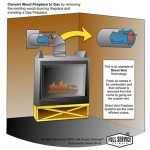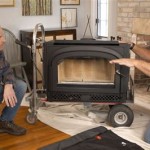Understanding Fireplace Millivolt Gas Valves
The fireplace millivolt gas valve is a critical component in many gas-fueled fireplaces. It is responsible for controlling the flow of gas to the burner, ensuring safe and efficient operation. This valve operates on a very low voltage, typically in the range of 500-750 millivolts, hence the name "millivolt." This low voltage is generated by a thermocouple or thermopile, heated by the pilot flame. This design offers a level of safety and reliability, particularly during power outages, as the fireplace can continue to function independently of an external electrical supply. The workings and functionality of this valve are essential for understanding the overall operation and maintenance of a gas fireplace system.
The millivolt system is a self-powered control system, meaning it requires no external power source to operate once the pilot light is lit. This makes it a particularly reliable solution for fireplaces, especially in regions prone to power interruptions. The system consists of several key components: the pilot assembly (including the pilot burner, thermocouple or thermopile, and pilot gas line), the gas valve itself, and the wiring connecting these components. The thermocouple or thermopile generates a small electrical current when heated by the pilot flame. This current is what powers the gas valve, allowing it to open and release gas to the main burner. This design ensures that gas only flows when the pilot light is actively burning, significantly reducing the risk of gas leaks.
The reliability and relatively simple design of the millivolt system have made it a popular choice for gas fireplaces for many years. However, understanding its operation and potential issues is crucial for both homeowners and service technicians. This article aims to provide a comprehensive overview of the fireplace millivolt gas valve, covering its function, components, troubleshooting, and maintenance.
Key Point #1: Components and Functionality
The fireplace millivolt gas valve system comprises several interconnected components, each playing a vital role in the safe and efficient operation of the fireplace. Understanding these components and their individual functions is essential for diagnosing and resolving any issues that may arise.
Pilot Assembly: The pilot assembly is responsible for establishing and maintaining the pilot flame. This assembly typically includes the pilot burner, a small gas nozzle that delivers gas to the pilot flame; the thermocouple or thermopile, which generates the millivolt current; and the pilot gas line, which supplies gas to the pilot burner. The pilot flame is crucial as it provides the heat source for the thermocouple or thermopile and ignites the main burner gas when the valve is open.
Thermocouple/Thermopile: The thermocouple is a thermoelectric device consisting of two dissimilar metal wires joined at one end. When the junction is heated by the pilot flame, a small voltage (in millivolts) is generated. A thermopile is essentially a collection of thermocouples connected in series to produce a higher voltage output. The generated voltage serves as the power source to hold the main gas valve open. If the pilot flame is extinguished, the thermocouple or thermopile cools down, the voltage drops, and the gas valve closes, shutting off the gas supply.
Gas Valve: The gas valve is the central control point for the gas flow to the main burner. It is an electrically operated valve that is activated by the millivolt current generated by the thermocouple or thermopile. When sufficient millivolt current is present, the valve opens, allowing gas to flow to the main burner. When the current drops below a certain threshold (typically due to the pilot light going out), the valve closes, preventing gas flow. The gas valve often incorporates safety features such as a pressure regulator to maintain a consistent gas pressure and a manual shut-off valve for emergency situations.
Wiring and Connections: The wiring connecting the thermocouple/thermopile and the gas valve is crucial for transmitting the millivolt current. These wires must be properly connected and free of corrosion or damage to ensure reliable operation. Loose connections or corroded terminals can disrupt the flow of current, preventing the gas valve from opening or causing intermittent operation.
The interaction of these components is what allows the fireplace to function safely and effectively. The pilot flame heats the thermocouple/thermopile, generating a millivolt current that powers the gas valve, allowing gas to flow to the main burner. This self-powered system provides a level of reliability that is independent of external power sources, making it a valuable safety feature.
Key Point #2: Troubleshooting Common Issues
While the millivolt gas valve system is generally reliable, issues can arise that prevent the fireplace from operating correctly. Understanding common problems and diagnostic procedures can help identify and resolve these issues efficiently.
Pilot Light Problems: One of the most common issues is a pilot light that will not light or stay lit. This can be caused by a variety of factors, including a dirty pilot burner, a faulty thermocouple/thermopile, a blocked pilot gas line, or low gas pressure. Start by visually inspecting the pilot burner for any debris or obstructions. Clean the burner with a small brush or compressed air if necessary. Next, check the thermocouple/thermopile output voltage with a multimeter. If the voltage is below the manufacturer's specification, the thermocouple/thermopile may need to be replaced. Ensure the pilot gas line is free from kinks or obstructions that could restrict gas flow. Finally, verify that the gas pressure to the fireplace is within the acceptable range.
Main Burner Not Igniting: If the pilot light is lit but the main burner will not ignite, the problem may lie with the gas valve itself. Check the millivolt output from the thermocouple/thermopile while attempting to light the main burner. If the voltage drops significantly when the main burner is engaged, it could indicate a problem with the gas valve's internal components. Also, examine the main burner orifices for blockages or debris. Clean the orifices with a small wire or compressed air. In some cases, the gas valve may be faulty and require replacement.
Intermittent Operation: Intermittent operation can be frustrating to troubleshoot. This issue can stem from loose wiring connections, a failing thermocouple/thermopile, or a partially blocked gas line. Inspect all wiring connections for corrosion or looseness. Tighten any loose connections and clean corroded terminals. Monitor the thermocouple/thermopile output voltage over time to see if it fluctuates erratically. A failing thermocouple/thermopile may produce inconsistent voltage output. Check the gas line for any restrictions that could cause intermittent gas flow.
Gas Leaks: Gas leaks are a serious safety concern and should be addressed immediately. If you suspect a gas leak, shut off the gas supply to the fireplace and contact a qualified gas technician. Common sources of gas leaks include loose connections, corroded gas lines, and faulty gas valves. Use a gas leak detector or a soapy water solution to check for leaks at all connections and fittings. Never attempt to repair a gas leak yourself unless you are a qualified technician.
When troubleshooting any fireplace issue, it is essential to follow safety precautions. Always turn off the gas supply before working on the fireplace and ensure proper ventilation in the area. If you are unsure about any aspect of the troubleshooting process, consult a qualified gas technician.
Key Point #3: Maintenance and Safety Considerations
Regular maintenance and adherence to safety guidelines are crucial for ensuring the long-term performance and safe operation of a fireplace millivolt gas valve system. Proactive maintenance can prevent many common issues and extend the lifespan of the components.
Regular Inspections: Conduct regular visual inspections of the fireplace, including the pilot assembly, gas valve, and wiring. Look for any signs of corrosion, damage, or wear. Check the pilot flame for proper size and color. A weak or yellow flame may indicate a dirty pilot burner or low gas pressure. Inspect the wiring for any loose connections or frayed insulation. Replace any damaged components immediately.
Cleaning and Maintenance: Clean the pilot burner and main burner orifices regularly to prevent clogs. Use a small brush or compressed air to remove any debris or carbon buildup. Clean the thermocouple/thermopile with a fine abrasive pad to remove any oxidation. Inspect the gas lines for any kinks or obstructions. Ensure proper ventilation around the fireplace to prevent the buildup of carbon monoxide.
Professional Servicing: Schedule professional servicing of the fireplace at least once a year. A qualified gas technician can perform a thorough inspection of the system, including a pressure test, gas leak detection, and component evaluation. The technician can also clean and adjust the burners, check the gas valve functionality, and ensure that all safety features are working correctly.
Safety Precautions: Always follow safety precautions when operating and maintaining a gas fireplace. Never store flammable materials near the fireplace. Ensure that the fireplace is properly vented to the outside to prevent the buildup of carbon monoxide. Install a carbon monoxide detector in your home and check it regularly. Never attempt to repair a gas leak yourself. If you suspect a gas leak, evacuate the area and contact a qualified gas technician or the gas company immediately.
Component Replacement: When replacing any components in the millivolt system, use only genuine replacement parts recommended by the manufacturer. Using aftermarket or incompatible parts can compromise the safety and performance of the fireplace. Ensure that the replacement parts are properly installed and tested before operating the fireplace.
By following these maintenance and safety guidelines, homeowners can ensure the safe and efficient operation of their fireplace millivolt gas valve system for many years to come. Regular maintenance and prompt attention to any issues can prevent costly repairs and ensure the safety of their home and family.

Sit 820 Series Millivolt Fireplace Valve 225 Degree 30 Turndown Natur Fire Parts Com

Sit 820 Series Millivolt Fireplace Valve 225 Degree 30 Turndown Natur Fire Parts Com

Sit Replacement Hi Lo Millivolt Valve

Grand Canyon Quick Mount Millivolt Valve Kit

Sit 820 Series Millivolt Fireplace Valve 30 Turndown Natural Gas Vent Fire Parts Com

Sit 820 Series Millivolt Fireplace Valve 30 Turndown Propane

What Fireplace Remote Control Works For You Skytechfireplaceremotes Com

Fireplace Gas Log Millivolt Remote Capable Natural Valve Kit Mvk N New

Natural Gas Millivolt Dexen 6003 Valve Mvk Nqm Quick Mount

Sit 820 Series Millivolt Fireplace Valve 30 Turndown Natural Gas Fire Parts Com
Related Posts








